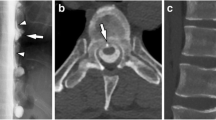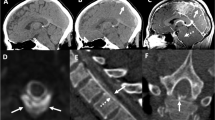Abstract
Spontaneous intracranial hypotension (SIH) is a rare neurological condition caused by low cerebrospinal fluid (CSF) volume, most commonly due to a CSF leak. The most common presenting symptom is an orthostatic headache, but some patients may present with atypical neurological manifestations such as cranial nerve palsies, an altered mental status, and movement disorders, which complicate the clinical diagnosis. Therefore, the diagnosis is based on the combination of clinical signs and symptoms, neuroimaging, and/or a low cerebrospinal fluid pressure. In this review, we describe the wide variety of neurological manifestations and complications seen in patients with SIH as well as the most common features described on imaging studies, including both subjective and objective measurements, in order to lead the clinician to a correct diagnosis. The prompt and correct management of patients with SIH will help prevent the development of life-threatening complications, such as subdural hematomas, cerebral venous thrombosis, and coma, and avoid unnecessary invasive procedures.




Similar content being viewed by others
Change history
28 May 2021
A Correction to this paper has been published: https://doi.org/10.1007/s10072-021-05323-x
References
Smith KA. (2016); Spontaneous intracranial hypotension: targeted or blind blood patch. J Clin Neurosci [Internet]. 25:10–2. Available from: https://doi.org/10.1016/j.jocn.2015.07.009
Michali-Stolarska M, Bladowska J, Stolarski M, Sąsiadek MJ (2018) Diagnostic imaging and clinical features of intracranial hypotension – review of literature. Polish J Radiol 83:e11–e18
Davidson B, Nassiri F, Mansouri A, Badhiwala JH, Witiw CD, Shamji MF, et al. (2017); Spontaneous intracranial hypotension: a review and introduction of an algorithm for management. World Neurosurg [Internet]. 101:343–9. Available from: https://doi.org/10.1016/j.wneu.2017.01.123
Vincent M, Wang S (2018) Headache classification committee of the International Headache Society (IHS) the international classification of headache disorders, 3rd edition. Cephalalgia 38(1):1–211
Urbach H (2014) Intracranial hypotension: clinical presentation, imaging findings, and imaging-guided therapy. Curr Opin Neurol 27(4):414–424
Idrissi AL, Lacour JC, Klein O, Schmitt E, Ducrocq X, Richard S (2015) Spontaneous intracranial hypotension: characteristics of the serious form in a series of 24 patients. World Neurosurg 84(6):1613–1620
Amrhein TJ, Kranz PG. (2019); Spontaneous intracranial hypotension: imaging in diagnosis and treatment. Radiol Clin North Am [Internet]. 57(2):439–51. Available from: https://doi.org/10.1016/j.rcl.2018.10.004
Cohen-Gadol AA, Mokri B, Piepgras DG, Meyer FB, Atkinson JLD (2006) Surgical anatomy of dural defects in spontaneous spinal cerebrospinal fluid leaks. Neurosurgery. 58(SUPPL. 2):238–245
Schievink WI, Reimer R, Folger WN (1994) Surgical treatment of spontaneous intracranial hypotension associated with a spinal arachnoid diverticulum. Case report. J Neurosurg 80(4):736–739
Farb RI, Nicholson PJ, Peng PW, Massicotte EM, Lay C, Krings T, terBrugge K (2019) Spontaneous intracranial hypotension: a systematic imaging approach for CSF leak localization and management based on MRI and digital subtraction myelography. Am J Neuroradiol 40(4):745–753
Kranz PG, Luetmer PH, Diehn FE, Amrhein TJ, Tanpitukpongse TP, Gray L (2016) Myelographic techniques for the detection of spinal CSF leaks in spontaneous intracranial hypotension. Am J Roentgenol 206(1):8–19
Kranz PG, Stinnett SS, Huang KT, Gray L (2013) Spinal meningeal diverticula in spontaneous intracranial hypotension: analysis of prevalence and myelographic appearance. Am J Neuroradiol 34(6):1284–1289
Schievink WI, Schwartz MS, Maya MM, Moser FG, Rozen TD (2012) Lack of causal association between spontaneous intracranial hypotension and cranial cerebrospinal fluid leaks: clinical article. J Neurosurg 116(4):749–754
Schievink WI, Maya MM, Jean-Pierre S, Nuño M, Prasad RS, Moser FG (2016) A classification system of spontaneous spinal CSF leaks. Neurology. 87(7):673–679
Schievink WI. (2006); Spontaneous spinal cerebrospinal fluid and ongoing investigations in this area. Jama. 295(19)
Mokri B (2015) Spontaneous intracranial hypotension. Contin Lifelong Learn Neurol 21(4):1086–1108
Hadizadeh DR, Kovács A, Tschampa H, Kristof R, Schramm J, Urbach H (2010) Postsurgical intracranial hypotension: diagnostic and prognostic imaging findings. Am J Neuroradiol 31(1):100–105
Kim JH, Roh H, Yoon WK, Kwon TH, Chong K, Hwang SY, Kim JH (2019) Clinical features of patients with spontaneous intracranial hypotension complicated with bilateral subdural fluid collections. Headache. 59(5):775–786
Ferrante E, Trimboli M, Rubino F. (2019); Spontaneous intracranial hypotension: review and expert opinion. Acta Neurol Belg [Internet]. (0123456789). Available from: https://doi.org/10.1007/s13760-019-01166-8
Ferrante E, Savino A (2005) Thunderclap headache caused by spontaneous intracranial hypotension. Neurol Sci 26(SUPPL. 2):155–157
Marshall N, Maclaurin WA, Koulouris G (2007) MRA captures vasospasm in fatal migrainous infarction. Headache. 47(2):280–283
Ducros A, Bousser M-G (2009) Reversible cerebral vasoconstriction syndrome. Pract Neurol 9:256–257
Takai K, Niimura M, Hongo H, Umekawa M, Teranishi A, Kayahara T, et al. (2019); Disturbed consciousness and coma: diagnosis and Management of Intracranial Hypotension Caused by a spinal cerebrospinal fluid leak. World Neurosurg [Internet]. 121:e700–11. Available from: https://doi.org/10.1016/j.wneu.2018.09.193
Schievink WI, Jean-Pierre S, Maya MM, Moser FG, Nuño M (2018) Coma: a serious complication of spontaneous intracranial hypotension. Neurology. 90(19):E1638–E1645
Hodges JR. (2001); Frontotemporal dementia (Pick’s disease): clinical features and assessment. Neurology. 56(11 SUPPL. 4)
Sayao AL, Heran MKS, Chapman K, Redekop G, Foti D (2009) Intracranial hypotension causing reversible frontotemporal dementia and coma. Can J Neurol Sci 36(2):252–256
Wicklund MR, Mokri B, Drubach DA, Boeve BF, Parisi JE, Josephs KA (2011) Frontotemporal brain sagging syndrome: an SIH-like presentation mimicking FTD. Neurology. 76(16):1377–1382
Ozyigit A, Michaelides C, Natsiopoulos K (2018) Spontaneous intracranial hypotension presenting with frontotemporal dementia: a case report. Front Neurol 9(August):1–5
Hedna VS, Kumar A, Miller B, Bidari S, Salardini A, Waters MF, Hella M, Valenstein E, Eisenschenk S (2014) Intracranial hypotension masquerading as nonconvulsive status epilepticus: report of 3 cases. J Neurosurg 120(3):624–627
Kim SC, Ryoo I, Sun HY, Park SW (2019) MRI findings of spontaneous intracranial hypotension: usefulness of straight sinus distention. Am J Roentgenol 212(5):1129–1135
He FF, Li L, Liu MJ, Di Zhong T, Zhang QW, Fang XM (2018) Targeted epidural blood patch treatment for refractory spontaneous intracranial hypotension in China. J Neurol Surgery, Part B Skull Base 79(3):217–223
Christoforidis GA, Mehta BA, Landi JL, Czarnecki EJ, Piaskowski RA (1998) Spontaneous intracranial hypotension: report of four cases and review of the literature. Neuroradiology. 40(10):636–643
Horton JC, Fishman RA (1994) Neurovisual findings in the syndrome of spontaneous intracranial hypotension from dural cerebrospinal fluid leak. Ophthalmology [Internet] 101(2):244–251. Available from:. https://doi.org/10.1016/S0161-6420(94)31340-6
Porta-Etessam J, Di Capua D, Jorquera M, Cuadrado ML, Marcos A (2011) Orthostatic headache and bilateral abducens palsy secondary to spontaneous intracranial hypotension. J Headache Pain 12(1):109–111
Khemka S, Mearza AA (2006) Isolated sixth nerve palsy secondary to spontaneous intracranial hypotension. Eur J Neurol 13(11):1264–1265
Zada G, Solomon TC, Giannotta SL (2007) A review of ocular manifestations in intracranial hypotension. Neurosurg Focus 23(5):1–5
Pakiam AS, Christine L, Lang AE (1999) Intracranial hypotension with parkinsonism, ataxia, and bulbar weakness. Arch Neurol 56(7):869–872
Duvall JR, Robertson CE, Cutsforth-Gregory JK, Carr CM, Atkinson JLD, Garza I (2019) Headache due to spontaneous spinal cerebrospinal fluid leak secondary to cerebrospinal fluid-venous fistula: case series. Cephalalgia. 39(14):1847–1854
Schievink WI, Nuño M, Rozen TD, Maya MM, Mamelak AN, Carmichael J, Bonert VS (2015) Hyperprolactinemia due to spontaneous intracranial hypotension. J Neurosurg 122(5):1020–1025
Shah LM, McLean LA, Heilbrun ME, Salzman KL (2013) Intracranial hypotension: improved MRI detection with diagnostic intracranial angles. Am J Roentgenol 200(2):400–407
Schievink WI, Chu RM, Maya MM, Johnson JP, Cohen HCM (2013) Spinal manifestations of spontaneous intracranial hypotension: clinical article. J Neurosurg Spine 18(1):96–101
Schievink WI, Maya MM (2006) Quadriplegia and cerebellar hemorrhage in spontaneous intracranial hypotension. Neurology. 66(11):1777–1778
Schievink WI, Maya MM (2008) Cerebral venous thrombosis in spontaneous intracranial hypotension. Headache. 48(10):1511–1519
Takahashi K, Mima T, Akiba Y (2016) Chronic subdural hematoma associated with spontaneous intracranial hypotension: therapeutic strategies and outcomes of 55 cases. Neurol Med Chir (Tokyo) 56(2):69–76
De Noronha RJ, Sharrack B, Hadjivassiliou M, Romanowski CAJ (2003) Subdural haematoma: a potentially serious consequence of spontaneous intracranial hypotension. J Neurol Neurosurg Psychiatry 74(6):752–755
Watanabe A, Horikoshi T, Uchida M, Koizumi H, Yagishita T, Kinouchi H (2009) Diagnostic value of spinal MR imaging in spontaneous intracranial hypotension syndrome. Am J Neuroradiol 30(1):147–151
Kranz PG, Tanpitukpongse TP, Choudhury KR, Amrhein TJ, Gray L (2016) Imaging signs in spontaneous intracranial hypotension: prevalence and relationship to CSF pressure. Am J Neuroradiol 37(7):1374–1378
Kranz PG, Gray L, Amrhein TJ (2018) Spontaneous intracranial hypotension: 10 myths and misperceptions. Headache. 58(7):948–959
Kumar MK (2017) Spontaneous intracranial hypotension - MRI features. J Tumor Med Prev 1(3):100–106
Holbrook JF, Hudgins PA, Bruce BB, Saindane AM. (2017); Novel orbital findings of intracranial hypotension. Clin Imaging [Internet]. 41:125–31. Available from: https://doi.org/10.1016/j.clinimag.2016.10.019
Mokri B (2014) Radioisotope cisternography in spontaneous CSF leaks: interpretations and misinterpretations. Headache. 54(8):1358–1368
Dobrocky T, Grunder L, Breiding PS, Branca M, Limacher A, Mosimann PJ, Mordasini P, Zibold F, Haeni L, Jesse CM, Fung C, Raabe A, Ulrich CT, Gralla J, Beck J, Piechowiak EI (2019) Assessing spinal cerebrospinal fluid leaks in spontaneous intracranial hypotension with a scoring system based on brain magnetic resonance imaging findings. JAMA Neurol 76(5):580–587
Schievink WI, Dodick DW, Mokri B, Silberstein S, Bousser MG, Goadsby PJ (2011) Diagnostic criteria for headache due to spontaneous intracranial hypotension: a perspective. Headache. 51(9):1442–1444
Ragab A, Facharzt KN. (2014); Caffeine, is it effective for prevention of postdural puncture headache in young adult patients? Egypt J Anaesth [Internet] 30(2):181–186. Available from: https://doi.org/10.1016/j.egja.2013.11.005
Goadsby PJ, Boes C (2002) New daily persistent headache. J Neurol Neurosurg Psychiatry 72(II):ii6–ii9
Wu W, Hseu SS, Fuh JL, Lirng JF, Wang YF, Chen WT et al (2017) Factors predicting response to the first epidural blood patch in spontaneous intracranial hypotension. Brain. 140(2):344–352
Kong DS, Park K, Nam DH, Lee JI, Kim JS, Eoh W et al (2005) Clinical features and long-term results of spontaneous intracranial hypotension. Neurosurgery 57(1):91–95
Author information
Authors and Affiliations
Contributions
Victor Garcia-Navarro, MD FAANS, had the idea of the article. Carlos Perez-Vega, Pilar Robles-Lomelin, MD, and Isabel Robles-Lomelin performed the literature review and writing of the article. Victor Garcia-Navarro critically revised the work.
Corresponding author
Ethics declarations
Conflict of interest
The authors declare that they have no conflict of interest.
Ethical approval
None
Additional information
Publisher’s note
Springer Nature remains neutral with regard to jurisdictional claims in published maps and institutional affiliations.
Rights and permissions
About this article
Cite this article
Perez-Vega, C., Robles-Lomelin, P., Robles-Lomelin, I. et al. Spontaneous intracranial hypotension: key features for a frequently misdiagnosed disorder. Neurol Sci 41, 2433–2441 (2020). https://doi.org/10.1007/s10072-020-04368-8
Received:
Accepted:
Published:
Issue Date:
DOI: https://doi.org/10.1007/s10072-020-04368-8




